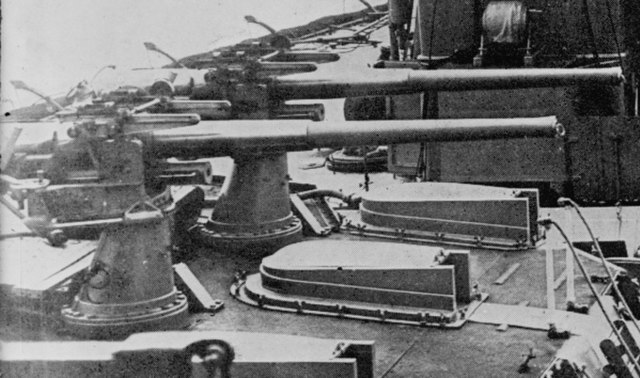The Nagato-class battleships were a pair of dreadnought battleships built for the Imperial Japanese Navy (IJN) towards the end of World War I, although they were not completed until after the war. The last of Japan's pre-Treaty capital ships, they were the first class to carry 41 cm (16.1 in) guns, the largest afloat and the first bigger than 15 inches (381 mm). Nagato, the lead ship of the class, frequently served as a flagship. Both ships carried supplies for the survivors of the Great Kantō earthquake in 1923. They were modernized in 1933–1936 with improvements to their armor and machinery and a rebuilt superstructure in the pagoda mast style. Nagato and her sister ship Mutsu briefly participated in the Second Sino-Japanese War in 1937 and Nagato was the flagship of Admiral Isoroku Yamamoto during the attack on Pearl Harbor on 7 December 1941 that began the Pacific War.
Nagato at sea
Office of Naval Intelligence recognition drawing of the Nagato class
A 41 cm 3rd Year Type gun from Mutsu on display at the Yamato Museum in Kure, Japan
A twin 127 mm gun mount aboard Nagato
The dreadnought was the predominant type of battleship in the early 20th century. The first of the kind, the Royal Navy's HMS Dreadnought, had such an effect when launched in 1906 that similar battleships built after her were referred to as "dreadnoughts", and earlier battleships became known as pre-dreadnoughts. Her design had two revolutionary features: an "all-big-gun" armament scheme, with an unprecedented number of heavy-calibre guns, and steam turbine propulsion. As dreadnoughts became a crucial symbol of national power, the arrival of these new warships renewed the naval arms race between the United Kingdom and Germany. Dreadnought races sprang up around the world, including in South America, lasting up to the beginning of World War I. Successive designs increased rapidly in size and made use of improvements in armament, armour, and propulsion throughout the dreadnought era. Within five years, new battleships outclassed Dreadnought herself. These more powerful vessels were known as "super-dreadnoughts". Most of the original dreadnoughts were scrapped after the end of World War I under the terms of the Washington Naval Treaty, but many of the newer super-dreadnoughts continued serving throughout World War II.

The Royal Navy's revolutionary HMS Dreadnought, launched in 1906, gave its name to the type
USS Texas, the only dreadnought still in existence, was launched in 1912 and is now a museum ship
12-pounder anti-torpedo boat guns mounted on the roof of a turret on Dreadnought (1906)
King George V (left) inspects HMS Neptune








